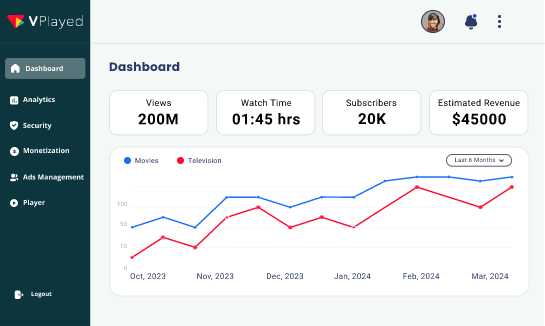What makes DRM the core of secure enterprise streaming infrastructure?
The pattern of content distribution within enterprises has shifted dramatically in recent years.
With corporates marching towards a more tech-savvy ecosystem, everyday operations and interactions have gotten a makeover with streaming.
Enterprises most often use online video platform to foster fruitful interaction among the workforce, deliver training modules, streamline onboarding processes, facilitate investor relations, and address town hall meetings.
In essence, this involves transmitting confidential information, organizational documentation, and other video materials that are of great value to the company.
Now, this kind of content demands a workflow that keeps it safe and secure from prying eyes, otherwise called piracy.
Table of Contents
What is DRM?
“DRM (Digital Rights Management) is a secure set of methodologies implemented to package premium content during storage and transit”
In other words, it forms a line of defense around the video streams from unauthorized access.
Enforcing DRM over copyrighted enterprise content makes sure it is accessible only to personnel who are authorized to view it through encryption and access control measures.
DRM levels up video security and restricts black market hackers from copying, modifying, or redistributing organizational data with business-specific access policies.
Especially in a corporate environment, DRM takes a front seat since there is constant sharing/ distribution of sensitive information among peers, business partners, stakeholders, etc.
How DRM Works?
The right holder’s asset (video) is encrypted using a secret key and only users who meet a certain set of criteria in accordance with the business model can decrypt and view the content on his device.
Once the user hits the playback button, the authenticity of his license is verified by a series of validations that include his
- Location
- Screen limit
- Device logged in from
- Time-based usage
- Credentials
- Subscription plan
among other factors that can be defined by the business owner. In total, user identity and usage rights are verified before the video is played on the end device.
When Should an Enterprise Employ DRM?
Corporates institute DRM into their streaming infrastructure when
- Sensitive data is transmitted within and outside of the organization
- The company wants to secure video streams from unauthorized access and theft
- There are threats of piracy
- Live streaming of virtual events should be curtailed from inadvertent sharing
- Streaming video content is licensed
- Copyrighted content ought to be protected from unintended disclosure
- View/ copy/ download rights got to be specified to employees, investors, or third parties
- Persistent video asset protection is to be instituted even after internal data is shared
Four Components of DRM for Securing Enterprise Content
To better understand how a DRM workflow is structured, here’s detailing how it ensures corporate streaming security.
-
Managing Digital Rights
Copyright compliance is a crucial factor when it comes to maintaining brand integrity and DRM is a definite collection of measures that shield the ownership or acquired rights on internal videos and intellectual content by imposing playback, streaming, and downloading rules.
-
Encryption
By the general rule of thumb, DRM-protected content is encrypted while in storage or in transit and can be deciphered only by an authorized user using the secret key.
-
Protecting End-User License Agreements
With DRM, enterprises can make it hard for a user to break the terms of the license. It also ensures the ownership of the content is intact from theft when allowed access to third parties or anyone outside the organization with a set of usage checks/ restrictions in place.
-
Imposing Playback Restrictions with DRM Enabled Player
Enterprise streaming demands a DRM-enabled player that can interact with the license server and impose playback restrictions.
Recommended Reading
List of DRM Service Providers Enterprises Can Choose From
S.No |
DRM Service Providers |
Highlights |
Compatible Devices |
|
1 |
Adobe Primetime DRM |
Content protection platform developed by Adobe Inc for securing Live, Linear, and on-demand premium videos |
Desktop, iOS, Android, Roku, Xbox, and all embedded system platforms |
2 |
Apple FairPlay Streaming |
Guards streaming media via encryption protocols and handles key exchanges for secure playback |
iOS, tvOS, and macOS |
3 |
Gumlet |
Gumlet is a state-of-the-art DRM protection tool that assists content creators in protecting their video streams using advanced encryption setups such as Google’s Widevine DRM and Apple Fairplay DRM. |
Chrome, Safari, Edge, Android, iOS |
4 |
Google Widevine |
Exclusively secures OTT platform and CAS content using royalty-free solutions; widely adopted by market giants |
Android, Google Chrome, Firefox, and consumer electronics like Samsung & Sony |
5 |
DivX |
Offers publishers and distributors control over their copyrighted content distribution |
Windows, macOS |
6 |
Intertrust Marlin |
Developed by MDC (Marlin Developer Community) and utilizes a general-purpose DRM infrastructure for securing digital content |
iOS and Android TV app devices |
7 |
Microsoft PlayReady |
Revolves around copy prevention technology via encryption and output protection; supports multiple business models |
Windows 8, Xbox, Windows Phone, Mediaroom, macOS |
How to Choose the Best DRM for Your Organization?
Implementing the right DRM solution for your corporate’s internal streaming architecture depends on the following factors
- Nature of the video content being streamed
- Digital threats your copyrighted content needs protection from
- The end-users who will view/ participate in the streams
- The browsers/ devices used to stream the content
- Should download/ screen capture be prohibited?
- The budget you are willing to spend on incorporating DRM
Once you’ve made a clear list of your requirements based on the above-mentioned attributes, it might come as an easy choice to pick the right DRM solution provider for your organization.
However, if you look at the streaming market giants, Adobe Primetime DRM, Apple’s FairPlay, and Microsoft PlayReady are the most widely used DRM solutions and are great for use across devices.
To conclude, DRM is an integral part of every streaming architecture not just with enterprises but every other vertical that distributes copyrighted content.
Along with securing sensitive information, it also ensures you exercise complete control over the organizational video content in storage and transit.
Besides administering a DRM solution into your workflow, you can also partner with a streaming solution provider with in-built DRM tools and techniques like CONTUS VPlayed.
Securing both on-demand and live corporate videos, CONTUS VPlayed aids in launching a professional streaming platform backed by DRM via encryption, dynamic watermarking, login protection, paywall integration, and SSL certificates, keeping sensitive information far from being compromised.

